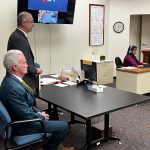A joint Assembly and Senate hearing in Trenton spent six hours last week trying to discern the factors driving up electricity bills. Despite posturing and politicking, there was agreement that the state needs more electricity generation to address the present imbalance between supply and demand.
The hearing March 28 came as ratepayers are about to get hit with 17% to 20% increases in the cost of the supply portion of their electricity bill beginning June 1.
The hearing by a Senate select committee and the Assembly Telecommunication and Utilities Committee was testimony to the importance the public attaches to the issue and the fact that the road to the November general elections begins in earnest with the primaries in just two months.
The hearing heard from Christine Guhl-Sadovy, president of the state Board of Public Utilities, Asim Haque, a senior vice president with grid operator PJM Interconnection, Abraham Silverman, a researcher at the Ralph O’Connor Sustainable Energy Institute at Johns Hopkins University, and New Jersey Rate Counsel Brian Lipman. Silverman, an attorney, served as general counsel for the BPU from 2019 to 2023.
Three questions repeated themselves throughout the testimony: Why are prices rising so rapidly? Who is to blame? What can be done quickly to have a positive impact on the soaring utility bills?
There was a general consensus that the state is suffering from a supply problem, and that extra generation of electricity is a must, using the most expeditious and least expensive sources. New Jersey does not generate enough electricity to satisfy its consumption; it is an importer of electricity.
According to Guhl-Sadovy, a problem is what she termed “artificial scarcity,” for which she placed the burden of responsibility on PJM. Commercial generators of electricity are not being connected to the grid fast enough, she said. PJM, she claims, has a long list of generators that are petitioning to be connected.
Along with interconnection issues, Guhl-Sadovy cited the need for better load predictions, improved infrastructure to carry a greater capacity, and energy efficiency programs that would help lower the amount of electricity used. She said the state’s utilities and PJM need to get better at predicting future load.
For Republicans on the panel, the answer to the problems of inadequate supply are rooted in the Murphy administration’s master plan for the state’s energy profile. This problem, said Sen. Anthony Bucco (R-25), is exacerbated by the premature loss of generating capacity from natural gas prior to the state’s ability to replace the lost volume of electricity with renewable sources.
Bucco afterward blamed Murphy and the Democrats. For him the hearings confirmed that the root cause of the problem is the failed plan to transition the state quickly to green energy generation, and with goals that undermined investment in more traditional sources of generation like natural gas and nuclear power.
Sen. Michael Testa (R-1) said, “Many of us saw what was happening today from a mile away. We knew that going all-in on offshore wind was a really bad idea.”
Democrats were more likely to place more of the blame on PJM, although both sides beat up on the grid operator. A number of Democratic panel members saw PJM’s market rules as having a negative impact on the results of electricity capacity auctions.
Democratic lawmakers seemed particularly anxious to divert attention away from state policies since the governor’s chair and all 80 seats in the Assembly are on the November ballot. The Democrats currently hold a 58 to 28 majority in the Assembly.
As the testimony made clear, demand for electricity in the state grew slowly for years before the current surge. Load forecasts only recently began to account for a fast-rising need for power at artificial intelligence data centers. PJM’s Haque said, “The industry is legitimately struggling with what is real on these data centers. It is not an easy issue to unpack.”
The picture becomes one of New Jersey engaged in a climate change-based transition in its energy profile only to run head-on into a new potential source of economic development that happens to have a voracious appetite for power. It comes down to whether a premature decommissioning of existing sources of supply made the state more vulnerable to the unexpected soaring demand of the data centers.
The message of the hearing was that the state is in a quandary, with no quick solution available. Silverman argued that battery or storage projects could probably come online faster than other types of generation. Yet he admitted that once they receive interconnection approval the wait time is still close to two years.
“Even small amounts of new megawatts can really have an outsized impact on prices, and we should be scouring the couch cushions for anything we can deploy in the next 18 to 24 months,” he said, ostensibly referring to looking for coins between cushions.
Lipman reminded the panel that extreme weather is also a culprit in the mix, since record-setting heat waves drive up use of electricity and put pressure on already taxed supplies. He pushed energy efficiency programs that would lower demand.
He also offered some legislative remedies that could be done immediately to have a positive impact on ratepayer bills even if those changes are not huge.
He suggested the Legislature require generators to join a regional transmission organization rather than pay them extra for joining one voluntarily, as is done now. He also argued for greater oversight of organizations receiving ratepayer money through subsidies funded by utility bill fees.
As the hearing ended, Assemblyman Wayne DeAngelo (D-14), who chairs the Assembly’s utilities committee, said lawmakers would conduct a second hearing in a few weeks to hear from representatives of utilities.
Contact the reporter, Vince Conti, at vconti@cmcherald.com.








